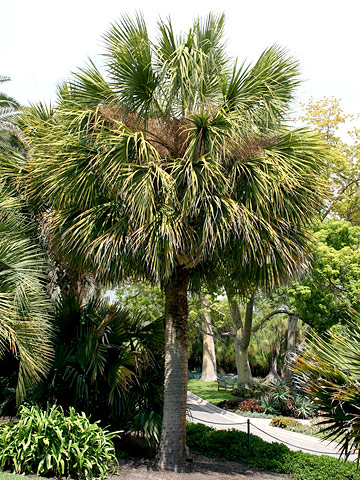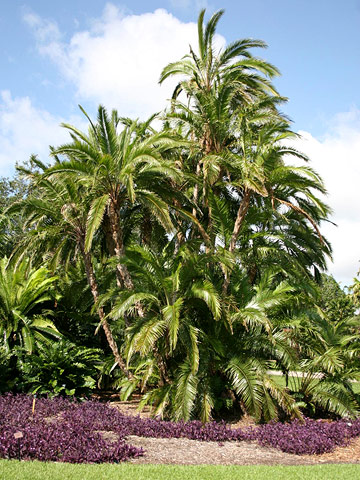






Palm trees are perfect for adding a tropical touch to your garden. But to keep your palms looking their best, make sure you know exactly what they need. There's not a one-size-fits-all answer -- it all depends on the type of palm you grow. First, determine where you plan on placing your palm. Then, use this guide to help determine what palm will thrive in that spot. The better you can make your plot, the happier your palm will be.
Palms can be picky when it comes to light. Knowing your palm's preferences is key. If a type of palm tree prefers sun, planting it in the shade will result in a weak plant that has a thick trunk and stretched-out palm tree leaves from reaching toward the sun. And if your palm loves shade and you plant it in direct sunlight, its leaves will burn and brown until they die.
Palms come from many different climate zones. Some species originate in places that are hot year-round. Highs hit 95 degrees F by day, while lows seldom dip below 78 degrees F at night. In mountainous regions, palms may see daytime highs in the 70s or 80s and nighttime lows in the 40s or 50s. Some species can occasionally see snow, while others brave temperatures exceeding 100 degrees F.
It simply comes down to knowing what your palm can tolerate -- especially at night. Some tolerate a wide range of temperatures; others can't. Taking into account the temperatures your area experiences year-round will help determine which species of palms will grow best for you.
The soil beneath your palm tree is just as important to its health as the sun above. And for palms, make sure you have the right soil type. Many species do well in either acid or alkaline ground; others are a bit fussy when it comes to soil. There is one piece of general advice for palms: Make sure the soil has good drainage.
Moisture is key for any plant, including palms. Some palms prefer moisture once a week (palms from desert areas may need even less), while others may prefer five times a week. If mixing palms, make sure you group them by water habits; otherwise you could jeopardize one plant while another thrives.
Finding the right palm tree is only half the battle. Once you've found the palm that fits your location, it's time to plant it. This is a crucial stage in your palm's life, and knowing the correct preparations is key.
Once you've picked the right spot, the next step to ensure palm tree success is to plant it right. In colder areas, plant palms in spring, when threat of freezing temperatures has passed. Avoid planting palm trees during dry seasons; young palms are more susceptible to damage from weather changes. When you're ready to plant your palm, dig a hole at least twice as wide as the diameter of the root ball, and make the hole no deeper than the root ball.
Be sure to exercise caution when handling your new palm tree, especially toward the heart. The heart is the delicate part from which the leaves grow, and if this cracks or shatters, your palm could have stunted growth or even die. Handle the root ball with care when removing it from the container. It may be easier to cut the container away from the palm to prevent root damage. Once the palm is out of the pot, level the hole so the bottom of its trunk is flush with the soil level of the yard. Then backfill it with loose soil to help promote root growth.

Bracing a palm typically works better than staking because palm trunks are often smooth, causing ties to slip down the trunk. Because a field-grown palm often has a smaller root ball than a container-grown plant, it's more top heavy and susceptible to toppling over in heavy winds. To prevent this, brace your palm in place for a year or until it has reestablished sufficient roots to stay anchored.
To start, take three or four braces of 2x4 lumber and equally space them around the palm. Make them long enough and place their bottom ends far enough from the palm tree to allow support in strong winds. Fasten these braces to the palm by wrapping burlap around the trunk at the appropriate height to protect the trunk from scratches and scrapes. Then secure an equal number of small pieces of wood with metal bands or similar ties that will not allow the wood to slip up or down the palm during high winds. Securely nail the braces into the small pieces of wood. Never nail directly into the palm. At the bottom of each brace, insert a 2x4 stake into the ground to nail the brace into. Leave the braces in place for one year or until the palm has reestablished sufficient roots to stay anchored.
Give your palm two to four weeks to acclimate to your garden before you apply any fertilizer. Once it's established, use a complete fertilizer that contains two parts nitrogen, one part phosphorus, and three parts potassium along with one part magnesium. Fertilize four times a year.
Additionally, water it frequently to help form more roots. Make a small dam on the soil surface around the outside of the root ball. Add water inside the dam to direct water into the root zone. If you're replanting a field-grown palm, it's going to need extra watering. This is because these trees have had their roots cut, and until they grow, they need all the help they can get reaching water.
Keep in mind that too much water may discourage roots from growing, delaying the palm's progress. Watering three or four times a week is sufficient for most species -- except moisture-loving palms, which will need more frequent watering. During unusually dry or hot weather, give new plantings extra water as well. Also, field-grown palms may require daily watering and, on hot days, watering in the morning and the evening. After three to four weeks, gradually cut back on watering to four or five times a week for another period of three to four weeks. Do this until your watering schedule is down to three or four times a week. If a palm's lower leaves turn yellow and brown, this could be a sign that it's thirsty for more water. However, be aware of drainage, because too much water can cause roots to rot.
If your soil drains well, use mulch to retain moisture and keep out weeds. As the mulch breaks down, it enriches the soil around the palm. Apply a 2- to 4-inch-deep layer with it thinner near the trunk and thicker over the root zone. This will help against excess mulch piling up, which can cause rot and fungal disease.
Be cautious with weed-control products. Some palm species are sensitive to herbicides. The palm can suffer damage if the herbicide comes in contact with green stems, foliage, or exposed roots. This could result in brown leaf spots, browning foliage, deformed new growth, and possibly death. Hand-pull weeds until the palm is more stable and grown.
Pruning palm trees is simple: Remove dead fronds (leaves) and old fruit stems. Once the old fronds turn completely brown, it's safe to prune them from the palm. Just make sure you wait until there is no green left on the frond. Use a hand pruner for smaller palms and a sharp pruning saw for larger leaf stems. Whichever pruning tool you choose, treat it with rubbing alcohol or hydrogen peroxide in between pruning different palms -- this helps prevent the spread of disease from plant to plant.
When removing a leaf, cut it as close to the trunk as possible. The remaining leaf base eventually falls off, but it may take several years. And if you try to strip it off before it's ready to fall off, you can scar the trunk.
If you have a large palm tree and can't reach old leaves with a pole saw, decide how important it is to prune your palm tree. Eventually the palm will shed its old fronds, but if you don't want to wait, you have a couple of options: hire a cherry picker or a tree climber.
Palm species vary greatly in their sensitivity to cold. Some palms can handle temperatures in the high teens for short periods, while others are damaged when temperatures hit 45 degrees F. Know the freezing patterns of your region, and make sure to buy a palm that can handle it.
Protecting your palm from cold damage can be simple. If you have a cold-sensitive palm, plant it in a warm microclimate, such as behind a windbreak or in a sheltered courtyard. This will protect it from the chill of winter winds. Or take potted palms indoors before freezing temperatures arrive. If the palm is too heavy to move, drape a lightweight blanket or sheet over your palm to trap heat inside and keep your plant 4 or 5 degrees warmer than the air.
If your area expects unusually cold temperatures, protect your palm with an outdoor propane heater. Keep the heater far enough from the palm to prevent burns. You may also water the soil around the palm prior to a cold snap; moist soil stays warm longer because water loses heat less rapidly than dry soil. Take care to keep water off the palm -- when water freezes on the palm, it causes damage to the plant tissues below.
Copyright © www.100flowers.win Botanic Garden All Rights Reserved